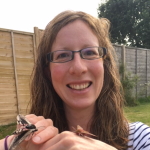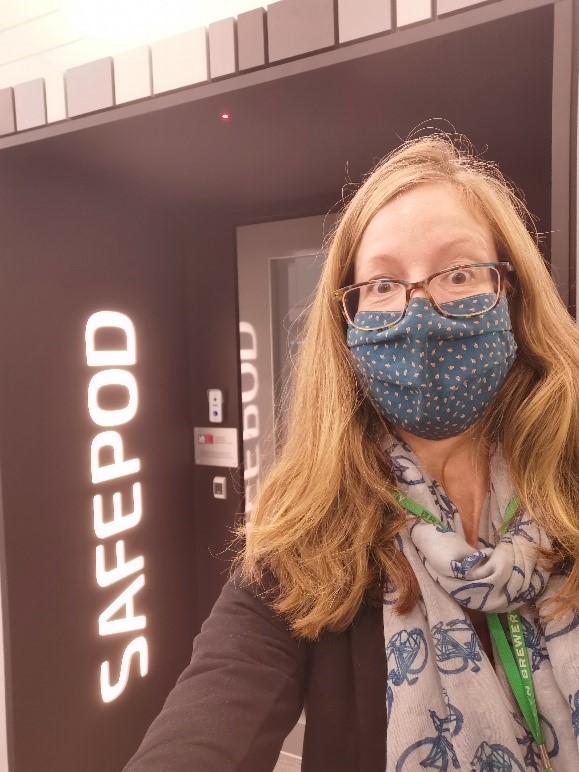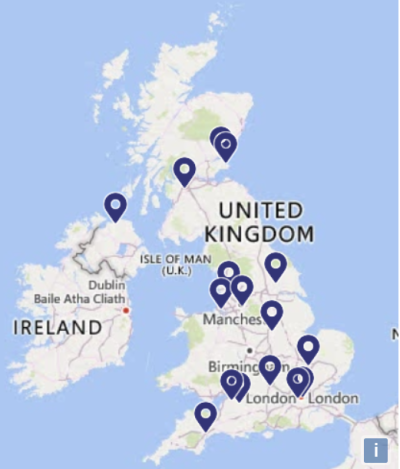 The SafePod Network is a brand new way to access secure data. We asked Sarah Knight, one of our #DataImpactFellows, to find out more – and take one for a spin! In the first post in a mini-series this week, Sarah looks into what SafePods are and why they are so important.
The SafePod Network is a brand new way to access secure data. We asked Sarah Knight, one of our #DataImpactFellows, to find out more – and take one for a spin! In the first post in a mini-series this week, Sarah looks into what SafePods are and why they are so important.
Last month I used a SafePod for the first time!
My university recently became part of the SafePod Network, installing a SafePod in the library, and became part of an exciting innovative research network that significantly improves access to secure data.

What is a SafePod?
SafePods are enclosed units containing a desk and a computer, and a range of security items, such as a door control access system, CCTV, and a locker for your belongings.
The SafePod Network (SPN) delivers access to secure data by providing standardised safe settings, SafePods, at locations across the UK.
SafePods allow access to secure data for approved researchers by delivering the required security and controls, underpinning the Five Safes framework.
There are currently 16 SafePods available for booking in the UK, with more awaiting installation or final setup.
Currently they can be used to access data from three Data Centres:
The SPN is funded by Economic and Social Research Council (ESRC), run by the Scottish Centre for Administrative Data Research, and is part of the Administrative Data Research UK (ADR UK) programme.
(https://safepodnetwork.ac.uk/safepod/)
Why is accessing secure data important?
I use the UK Data Service’s SecureLab environment to access the datasets I needed for my PhD and subsequent writing up research papers.
I access the British Household Panel Survey (BHPS) and the UK Household Longitudinal Study (UKHLS), both part of the Understanding Society programme.
Secure data (or controlled data) contain highly-detailed and sensitive information about individuals (or households, organisations etc) that risk disclosing individuals or characteristics.
The datasets that I use include highly accurate residential location data for survey participants and are therefore too detailed and sensitive for open access. They are also, therefore, too sensitive to be downloaded.
Consequently, a safe, secure, and controlled environment is required to access and analyse these data.
I have previously accessed these via the UK Data Service SecureLab environment from my office desktop (and more recently at home via my secure university VPN). While this has worked very effectively, this requires me to have a strong and consistent home internet connection and a comfortable and secure working environment.
According to the SafePod Network website, the SPN key objectives are to:
- Significantly improve the quantity and diversity of public benefit research by providing researchers with equitable and secure access to data through the provision of a network of standardised safe settings (SafePods) across the UK;
- Improve and widen the sharing of data held by data centres across the UK for public benefit research; and
- Provide clear information and sign posting for researchers to be able to access data for public benefit research from all safe settings across the UK.
Being able to access datasets in the SafePod gave me the opportunity to work in a quiet and secure environment with excellent and reliable computing power. Having a big screen was also a huge improvement on my small home laptop screen!
In tomorrow’s post, I will share with you my experience of booking and use a SafePod.
About the author
Sarah is an ESRC Postdoctoral Fellow at the Environment & Geography department, University of York investigating the links between socioeconomic and environmental inequalities and nature connectedness.
Specialising in nature-society relationships and geospatial approaches, Sarah is interested in employing quantitative, qualitative and participatory methods to study GIS, green and blue spaces, health & well-being inequalities & ecology. She has worked on several projects at York such as a Green Social Prescribing evaluation and the EU-funded H2020 PERICLES project. Sarah completed an ESRC White Rose funded PhD in 2020 on measuring the relationship between the natural environment and subjective well-being. This involved using regression methods to explore the determinants of human well-being from green/bluespace, air pollution, and biodiversity datasets at small-scale UK geographies. Prior to joining York, she worked in the environmental conservation sector for nearly 10 years in organisations such as UNEP-WCMC, FERA and ZSL.

